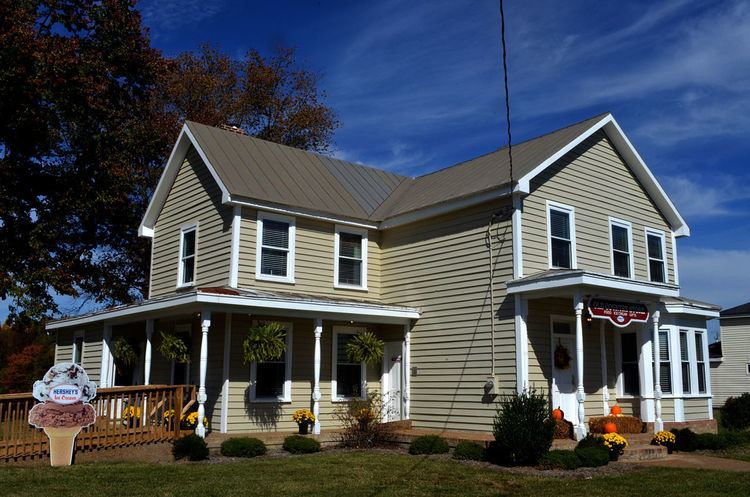Locale Chesterfield, Virginia Track gauge 3 ft (914 mm) | Dates of operation 1884-03-10–1905-06-07 | |
 | ||
Successor Tidewater and Western Railroad | ||
In 1886, Randolph Harrison, of the Virginia department of Agriculture, cited Cumberland Mining Company, stating that businessmen would soon open a hotel at Lithia Springs, Farmville, VA for people seeking the healing waters. The Brighthope railway would be extended to bring them there. But instead, the Farmville and Powhatan Railroad Company built the narrow gauge rails through Cumberland County and the Farmville and Powhatan Railroad Company bought the Brighthope Railway, so the Farmville and Powhatan Railroad made the connection. In 1890, Beach Station was built around 1890 with a railroad depot, some railroad shanties, a general store and an owner's house, the George Perdue House as a stop on the line.
Contents
History
The Farmville and Powhatan Railroad, a narrow gauge railroad was formed On March 10, 1884, in five years beginning building tracks from Farmville to Cumberland and Powhatan. The Farmville and Powhatan bought the Brighthope Railway in which was in foreclosure on July 23, 1889. On March 3, 1890, the Farmville and Powhatan Railroad was connected to the Brighthope Railway three miles west of Winterpock, taking the eastward part, all but seven miles, of the Brighthope Railway to Bermuda Hundred. After this line was build from Farmville to the Petersburg Area, the Upper Appomattox Canal Navigation System, which took days to make the same journey, would no longer be used.
Trains mostly hauled coal, lumber and then grain and tobacco and other farm products as well as a little furniture. There was one passenger only train and one train with passengers and cargo which each ran Weekdays and Saturday. The trains had five first class passenger cars for passengers. The trains carried U.S. Postal mail on two mail, freight and express mail cars. The company had 7 engines and 210 cars in 1890, but only five engines in 1896. Postal Telegraph Company operated the telegraph over the rails and charged customers for telegraphs. The railroad company employed 169 people including over 50 trackmen, who maintained the tracks; 18 who worked at the station as well as carpenters, machinists and other laborers.
Stations
The Farmville and Powhatan was a ninety three mile line after the merger. The rails had one bridge over the Atlantic Coast Line Railroad and the Swift Creek Rail Bridge.
An uncomfortable ride
A passenger from Powhatan Courthouse complained of the discontinuation of the early train of the F & P, that connected in Moseley with the Southern Railway, on the old Richmond and Danville Railroad rails. This forced him to take an uncomfortable ride on the F & P to Chester wich took longer each morning. The railroad replied that they needed to have trains that were full the entire route, starting no earlier than 5:50 in Farmville for people who had to walk a few miles to reach the train station. His train that had connected to the Southern had started at 4:50 A.M. in Farmville so had very few passengers in the beginning of the run.
Stop anywhere
Train operators running the passenger train would "Stop Anywhere". Red Lane Tavern was a common stop for the passenger train that was not listed on the schedule.
Fowlkes v. the Southern Railroad Co.
Mrs. Eva C. Fowlkes, on March 9, 1899, purchased a ticket on the Southern Railway from Richmond to Mosley Junction to connect to Skinquarter by way of the Farmville and Powhatan. The railroad ticket master had misinformed her and there was no connection that day. She did not see the small new Farmville and Powhatan ticket office in Mosley Junction and hired wagon to take her to her parents house in Skinquarter, Virginia. As she was pregnant, she had a miscarriage after the wagon ride which resulted in a lawsuit, Folkes v. the Southern Railway Co. in which the railroad was liable for only $150, the court ruled that the railroad attendant could not predict the events that would happen after the misinformation was given.
Modern pathway
Following the path of the old railroad today travels down Virginia State Route 10 from Bermuda Hundred on the north side of the Appomattox River and then east on Carver Heights Drive, Chester, through a landfill and housing complex, next to Bright Hope Road then along Beach Road to Winterpock, then one spur lead down where South on Coalboro Rd is today. The main line lead from Winterpock to Skinquarter up Local route 603 or Beaver Bridge Rd. Pasted Skinquarter it continued on 603 to 605 and up 605 which becomes Mosley Rd where it crossed the Southern Railway. It continued on 605 to 622 and up 622 to Flat Rock. From Flat Rock it followed near State Rt 60 to Powhatan where it then took Route 13 or Old Buckingham Road all the way to Cumberland, Virginia. From Cumberland it followed what is now Virginia State Route 45 to Farmville. Most of the stops are still towns today, even if only a sign and a few stores.
